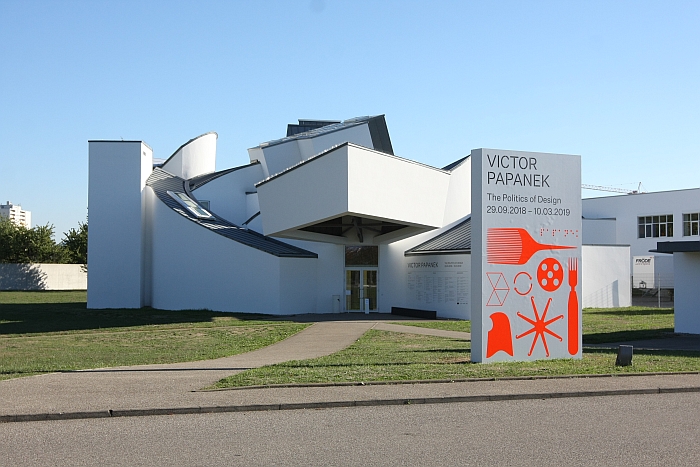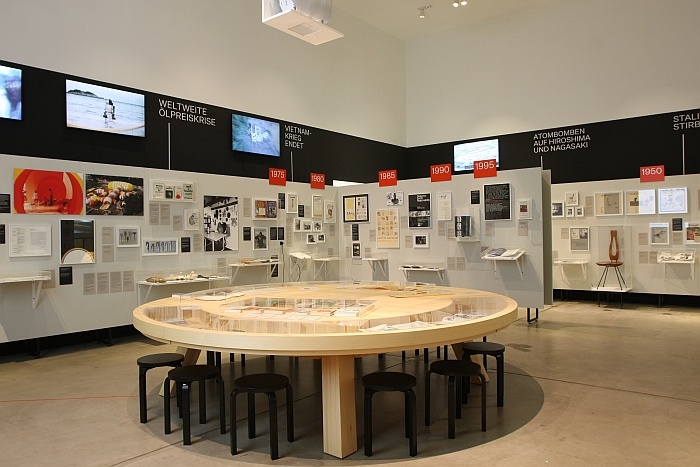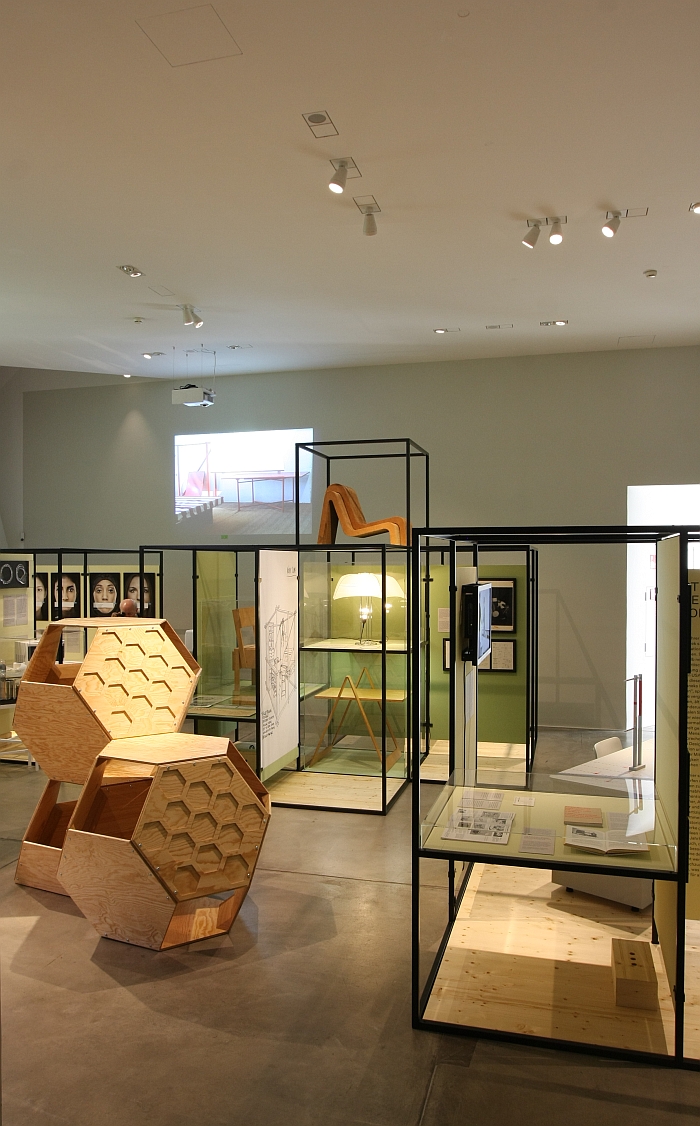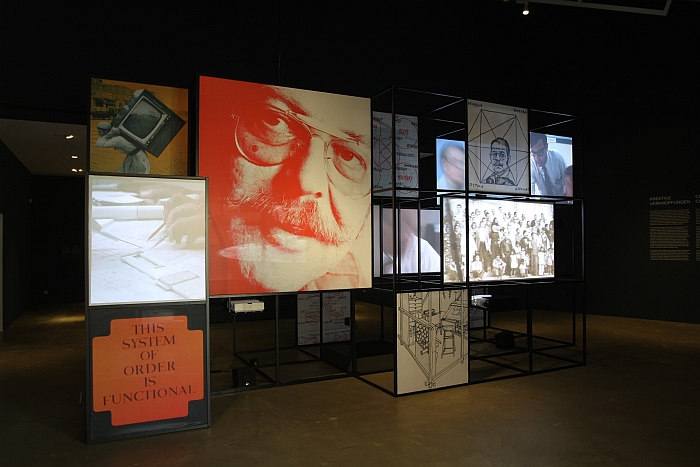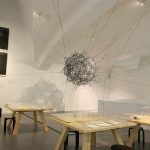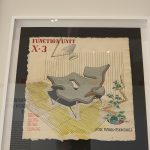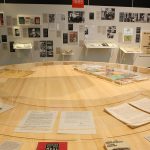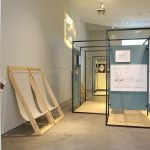Victor Papanek: The Politics of Design @ the Vitra Design Museum
Victor Papanek’s contention that “There are professions more harmful than industrial design, but only a very few of them”, remains one of the most pertinent considerations on the design profession, because it succinctly underscores that in what they do designers directly and indirectly impact not only the user/consumer of that which they design, but also on all those involved in the production, distribution and disposal of that which they design. And thereby, directly and indirectly, on our environment.
A pertinence that remains relevant despite the opinion being voiced in 1971.
With the exhibition Victor Papanek: The Politics of Design the Vitra Design Museum not only present the first major retrospective of Victor Papanek, his life and work but also investigate his wider contemporary relevance.
And indicate how designers could be less harmful, more useful…..
Born in Vienna on November 22nd 1923 as the son of the Jewish delicatessen owner Richard Papanek and his wife Helene, Victor Josef Papanek was forced to flee to America with his widowed mother in 1939. Following a course of studies in architectural design at the Cooper Union School of Art in New York Victor Papanek opened own studio “Design Clinic” in 1946 and from where he developed, principally, furniture designs.
Despite having started out on a (for the period) relatively conventional designer career, Victor Papanek increasingly turned to design as a social duty, rather than a commercial or industrial one, to an understanding of the designer as being not only responsible for form and function but also for the environment, the individual, society as a whole.
Which poses the very obvious question, why?
Although The Politics of Design doesn’t, at least as far as we saw, answer the question directly, and as ever, we may have missed it, the intelligent and logical exhibition design does lead the visitor towards a few very probable answers.
Opening with a biographical introduction to Victor Papanek, a necessity in context of a monographal exhibition of a designer with whom (relatively) few will be familiar; the biography however doesn’t just focus on the life of Victor Papanek, but his times, setting his chronology parallel with that of society in general.
The first clue as to Victor Papanek’s future direction comes early in the biographical chain, having arrived in America the young Papanek found himself in relative poverty, certainly in comparison to that he had known in Vienna, and as professor Alison J. Clark, Director of the Victor Papanek Foundation, and the exhibition’s co-curator, opined out at the opening, this experience of being one of the outsiders stayed with Victor Papanek and caused him to naturally empathise with the socially excluded and those on the outer edges of society.
Consequently as the boom years of the 1950s gave way to the babyboomer dominated 1960s Victor Papanek was, arguably, more receptive to many of the new impulses, new forms of thinking, new understandings of social, political and cultural orders developing in the USA, than many of his contemporaries
One of the first exhibits the visitor is confronted with is large graphic explaining Papanek’s “Creative Connections”, not only those whom Victor Papanek influenced but who influenced him, including the likes of Raymond Loewy, who, as the graphic states, stood for most everything Papanek rejected in design, and also those who influenced him more through emulation, including Alvar Aalto, the man who strove to bring humanism into functionalism, and perhaps most importantly Richard Buckminster Fuller, an energetic commentator on social and environmental themes, and another often underestimated protagonist of 20th century design, but a man who had a great influence on the development of 20th century American design, being important, for example, to the careers of Isamu Noguchi or George Nelson, as well as to that of Victor Papanek.
In addition, the biographical section of the exhibition presents examples of books published in the early 1960s such as Silent Spring by Rachel Carson, Understanding Media: The Extensions of Man by Marshall McLuhan or Unsafe at Any Speed: The Designed-In Dangers of the American Automobile by Ralph Nader, thus neatly underscoring how as the 1960s progressed the Cold War fear that we’re all going to die slowly gave way to the realisation that we we were already doing quite a good job of killing ourselves, that we didn’t need Armageddon, that with our chemicals, pollution, reckless fascination with the car, and imbalanced social realities, we were perfectly capable of wiping ourselves out.
In 1971 Victor Papanek published Design for the Real World, his answer to the world he perceived around him, his considerations on design and designers, and that designers not only have a responsibility to the world beyond creating products for industry to produce, but that through creating products for industry to produce designers are helping destroy the world, and that while “there are professions more harmful than industrial design, but only a very few of them”
And maybe designers should consider more carefully what they do. And for whom……
Having introduced Victor Papanek and his story, the Politics of Design moves effortlessly on to explore his wider work, be that as a designer, writer or educator, whereby arguably the later two are the most important in context of Victor Papanek: in addition to numerous books and essays Papanek taught at an impressive roster of international institutions and also held untold workshops with NGOs and local groups exploring and disseminating what we would now refer to as Social Design. His importance as an author and educator also being (arguably) one of the reasons that despite his relevance to the (hi)story of design he remains relatively unknown: or put another way, he didn’t realise any products which exist today in the portfolio of a major manufacturer. And only very few you are likely to encounter in a museum.
As with the Papanek biography the exploration of Papanek’s oeuvre doesn’t occur in isolation but rather in context of projects by his students and contemporaries and also projects by contemporary designers and creatives in which an inherent dialogue exists between the work of Victor Papanek. Thus alongside projects such as, and amongst many, many others, Papanek’s Tetrakaidecahedral movable playground system or a 1976 barrier free taxi developed in conjunction with Volvo, Marshall McLuhan’s Distant Early Warning problem solving/design thinking playing cards or the artificial burrs developed by Papanek’s students’ James Herold and Jolan Truan and intended to prevent soil erosion, just one of a whole raft of projects, historic and contemporary, inspired by nature, The Politics of Design also presents, and again among many others, the Bomba Hacker (hacker pump) by Flui Coletivo which enables one to reuse grey water in the home and thereby save water, Totomoxtle, a tile veneer from corn husks developed by Fernando Laposse or Tomás Saraceno’s Flying City, a modular architecture based on suspended, interlinked globes and which demands new social and cooperation systems to be maintained.
The result of this logically and very naturally mixed presentation of projects means that despite being very much a Victor Papanek retrospective, an exhibition which very clearly and competently explains the drives, aims and results of his life’s work, The Politics of Design is also very much about contemporary design, about contemporary design’s social responsibility and political relevance, and that not just in context of the 21st century projects presented and the dialogue they enjoy with Victor Papanek, but also beyond the exhibition, beyond the walls of the Gehry Building, and all those new problems we’re creating for ourselves, those new oceans of plastic we’re all going to be surprised to find polluting our environment in 30 years, for all new problem fields such as data control, autonomous transport, machine learning. If you will all those contemporary ways designers are proving their harmfulness to society.
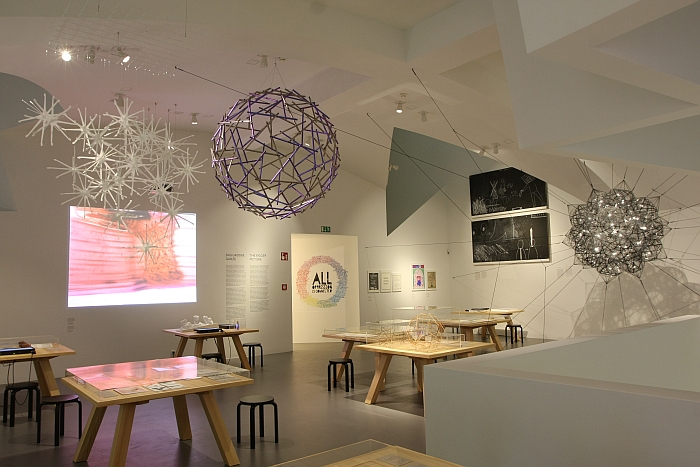
Victor Papanek: The Politics of Design, Vitra Design Museum Victor Papanek: The Politics of Design, Vitra Design Museum
An accessible and highly informative exhibition, The Politics of Design is quite likely to overpower you at first. It did us. On first glance it did and does look like an unassailable wall of information placed between you and that well earned coffee and cake; however, take a deep breadth, approach it slowly and you’ll quickly discover a very clearly, logically, and reduced display format. If one that by necessity does rely heavily on smaller objects, and for all smaller objects behind glass.
In addition to objects per se, including a number of Papanek’s 1973 Lean-to chair specially created for the exhibition and the visitors comfort, and which we forget to try, The Politics of Design also presents films, photographs, models and lecture notes which all contribute to explaining both who Victor Papanek was and his historic/contemporary relevance to both design and design’s contemporary relationship to the society from which it arises. As do the books. A veritable library. Including numerous copies of Design for the Real World available for visitors to read. Which we’d advise all unfamiliar with it to. On the one hand, you’ve paid you’ve money might as well, and on the other even the most basic of readings will help deepen your understanding, and thereby enjoyment, of the exhibition.
And help underscore the importance of Victor Papanek. He wasn’t the only designer or commentator of the period concerning themselves with such thoughts, was however one of the leading voices putting social responsibility in design on the agenda, and whereas there is certain amount of tragedy in the fact that in 2018 we are still concerning ourselves with topics a Victor Papanek was concerning himself with, today such themes are not slightly overtly hippy distractions in the world of design, but are much more mainstream.
Whereas, for example, in Design for the Real World Victor Papanek bemoans at length the lack of design school projects tackling the type of problems in which he was interested, today he wouldn’t have so much ground for complaint. A little, but less. Alone from our recent #campustour we can recall projects as, and amongst many others, Individual Cups by Annelie Hultman at Konstfack Stockholm which developed 3D printed cup handles for those with limited hand mobility, Bitesized by Natalie Fuller at Glasgow School of Art in which Natalie developed a pair of shears to allow those with the use of only one hand to cut up food, or the class R/E/Motions Tools and Toys in Reaction to Parkinson at Bauhaus Uni Weimar, a class which not only developed tools for Parkinson sufferers but, importantly, and relating to a central tenet of Papanek’s teaching, involved the patients and their families in the process rather then being top down design by “experts”, of the importance of listening to and engaging with others, for all those with actual experience rather than a theoretical position. And all indicating that Papanek’s ideas are an integrated part of contemporary design education and therefore ever more part of contemporary design thinking.
Arguably Victor Papanek became one of the leading protagonists of his age, and thereby achieved his current position, not least because he was one of the most active protagonists of his age.
One of the things that always strikes us when reading Design for the Real World is the ceaselessness of the creativity, it’s very much a case of: we developed pollution free cars for the Sahara, playground equipment for children with cerebral palsy, a signage system for refugee camps. Then we stopped for breakfast. Afterwards we devised a system for low-cost house building inspired by the lizard species Brexit stupidious, dictation machines for the deaf and led a workshop on algae powered batteries.*
It’s relentless. Absolutely relentless. In breadth, depth and also scale, ranging from projects with individuals to cooperations with major international companies and institutes. Yet not in arrogant look at me, look how superior I am to you, you killing the planet out there you, way, but much more in a self-explanatory way, in away that implies he can do no else, he is just following his natural instinct, an inner calling if you will. And this comes across very well in the exhibition, whereby one defining moment for us is a short video sequence in which Victor Papanek complains about shirt packaging. For many no great thing, for a Victor Papanek huge, and not just the outer plastic bag but all the pins, clips, inserts, etc. And that not just in the USA, but everywhere. When he then lists the countries where he has bought shirts and experienced over-packaging, you know he has. Know he’s that thorough, and thereby the impression is very much cemented of a man driven by the correctness of his position, aware of the need for change, desirous to explain his position to others and who was very well placed to demonstrate that there are professions more dangerous than industrial design, but only a very few of them.
If only there was something we could do……
Victor Papanek: The Politics of Design runs at the Vitra Design Museum, Charles-Eames-Straße 2, 79576 Weil am Rhein until Sunday March 10th.
Full details, including information on the accompanying fringe programme can be found at www.design-museum.de
*. A purely fictional passage. Any comparion to an actual passage in Design for the Real World is purely accidental…..
- Flying City by Tomás Saraceno, as seen at Victor Papanek: The Politics of Design, Vitra Design Museum
- Victor Papanek: The Politics of Design, Vitra Design Museum
- The Samisen Chair by Victor Papanek, as seen at Victor Papanek: The Politics of Design, Vitra Design Museum
- X-3 Function Unit by Victor Papanek, as seen at Victor Papanek: The Politics of Design, Vitra Design Museum
- Copies of Design for the Real World, as seen at Victor Papanek: The Politics of Design, Vitra Design Museum
- Victor Papanek: The Politics of Design, Vitra Design Museum
- The Lean-to chair by Victor Papanek, as seen at Victor Papanek: The Politics of Design, Vitra Design Museum
- Victor Papanek: The Politics of Design, Vitra Design Museum
- Victor Papanek’s biography, as seen at Victor Papanek: The Politics of Design, Vitra Design Museum
- Victor Papanek: The Politics of Design, Vitra Design Museum
- Victor Papanek: The Politics of Design, Vitra Design Museum
- Studying Papanek’s Creative Connections, as seen at Victor Papanek: The Politics of Design, Vitra Design Museum
Tagged with: #VDMPapanek, Victor Papanek, Victor Papanek: The Politics of Design, Vitra Design Museum, Weil am Rhein
